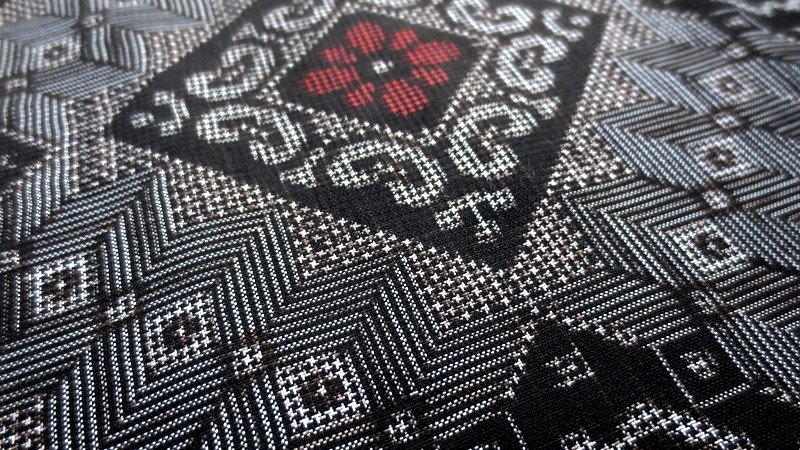Oshima Tsumugi 大島紬
Along with Persian Carpets and Goblin Tapestries, Oshima Tsumugi silk pongee is one of the world’s three greatest textiles. Amami Oshima Tsumugi is the premium silk pongee which symbolizes Amamian history, pride and folklore culture since Nara Era (1300 years ago). Natural mud-dyed Oshima Tsumugi gathers the eternal admiration of all Japanese women for its sumptuous shine, touch and tustles on the skin. It is their life long dream to own one Oshima Tsumugi kimono robe. The pongee of Oshima Tsumugi has noble dignity, and represents traditional artisan skills with a cultural inheritance.
Amami Islands consists of eight islands located in the area between Okinawa and mainland Kagoshima. The climate is oceanic semi-tropical with an average temperature at 21C (70F) and an annural rainfall of 3000mm.
The unique dying method uses the Amami’s iron-rich natural mud as a dye. This makes the silk threads into beautiful and luminous balck. After being taking off the loom, each plain weave textile has a unique and detailed graphical pattern made of over a million dots dyed onto each single silk thread before they are set onto the loom. It takes more than SIX MONTHS (!!!) to produce the final product through over 40 processes.
Dying Method -
A) Doro (Mud) Oshima Tsumugi- 1. Threads dyeing: Enriched liquid is obtained after boiling the trunk of “Techiki” in the water for about 10 minutes. Threads are dipped in the cooled liquid and crumpled by hand with a small amount of lime for about 15 minutes, and then dried in the sun. The process is repeated about 20 times. 2. Doro (mud) dyeing: Threads are dipped in ferrous muddy water and immersed well by crumpling, so that the color of the threads changes into brown. After 30 - 40 times of the repetition of the process, the threads become dark brown and more pliant. 3. Shiro (white) mud dyeing: Threads are dyed with white mud of the volcanic ashes of Mt. Sakurajima, an active volcano in Kagoshima Prefecture.
B) Ai (indigo) Oshima Tsumugi - Threads are dyed in indigo and patterns are left white.
C) Doro(mud) Ai (indigo) Oshima Tsumugi - Threads are dyed in light blue first then both “Techiki dyeing” and “much dyeing” are applied to them.
D) Iro (color) Oshima Tsumugi - Variety of “Doro Oshima” & “Ai Oshima”. red, yellow and green are added to them by chemical dyes.
E) Sharinbai Oshima Tsumugi - Sharinbai Tree is used as a dye. The dye of Sharinbai is enriched with tannin. Silk threads are dyed about 80 times with this dye.
As a result of studies, weaving patterns also developed from a simple “Tate - Yoko (warp and weft) Kasuri” to “Juji (cross) Kasuri” and “Kikko (tortoise shell, hexagonal) Kasuri”. Around 1900, a man invented a new technique called “Ori (weaving) Jime,” using a loom to dye threads. The technique enabled the production of varieties of Kasuri designs, resulting in an increase of the demand. The loom changed from “Jibata” (loom with no pedestral) to “Takahata” (high loom) which is more effective in weaving. Weaver can only weave 12 inches a day and takes about 6 months to make one roll. Thus the Oshima Tsumugi won the reputation as the highest quality fabric for clothes with precise designs.
In the mid - Edo Era (1700s), the Satsuma clan (today’s Kagoshima Prefecture) prohibited the residents in Amami Islands from weaving kimono made of Oshima Tsumugi. It was only supplied for the Satuma clan as part of thier tax. After the Meiji Era (late 1800s), many women in Amami Islands have been engaged in Oshima Tsumugi weaving, contributing to their family income at a great extent. In Amami Oshima Islands, the kimono was not ony a cloth; it has been believed to protect the wearer’s soul with a spiritual power. When wearing a new kimon for the first time, the wearer used to pray to the east (where sun rises) for the health of her / himself with some purifying salt in the month. People in Amami Islands call Oshima Tsumugi “Nono” with certain affection to the textile.
Yoko Beverly Hills offers authentic Oshima Tsumugi Collection. Click here Oshima



